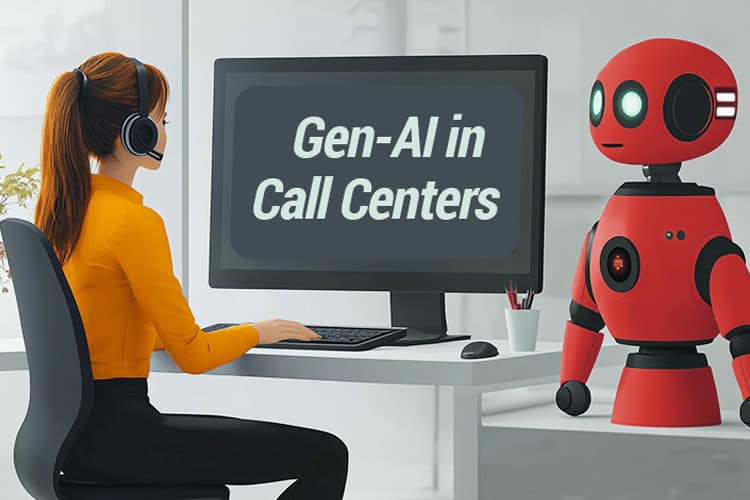The new face of customer support is changing rapidly, and right at the center of that evolution is Artificial Intelligence. Generative AI is increasingly proving a key differentiator in businesses for speedier, more personalized, and effective customer service. This is much more powerful than old chatbots because it can comprehend, generate, and learn from natural language information due to NLP and LLMs.
The shift from rule-based systems to intelligent, AI-driven platforms enables customer support teams to craft frictionless experiences that meet growing customer expectations. In this blog article, we look deep into how generative AI has changed the face and the pace of customer support: benefits accruing from the adoption, best ways to adopt, challenges accompanying such transition, and questions every leader should ask prior to its implementation.
How Generative AI Is Changing Customer Support
From Rule-Based Chatbots to NLP and LLMs
Traditional chatbots used to rely on fixed rules and preprogrammed scripts when interacting with customers. These systems worked for the most basic queries but often could not function where issues were raised to complex or even a little nuanced. It was too easy to detect its limitations by customers, which resulted in frustrating experiences among users and low satisfaction rates.
Generative AI is a quantum leap forward, harnessing the power of advanced NLP and large language models. They understand context, process natural language, and can respond indistinguishably from a human being. Unlike their first-gen cousins, generative AI chatbots improve incrementally over time, learning something from each interaction and folding feedback into future conversations. The end result is dynamic, personalized, accurate customer interactions.
For instance, rather than offering just pre-set answers, an AI model would understand a customer’s question, analyze it in real time, and offer responses tailored to previous interactions, intent, and context. The result is a more fluid conversation that better simulates responsiveness and understanding from a human agent.
The Rise of Machine Learning-Driven Solutions
ML allows generative AI to continuously evolve and becomes intelligent with every piece of data exposed to it. As time progresses, the AI develops further insight into customer preferences, common issues, and even nuances in language. This suggests that each customer conversation becomes a learning opportunity that improves not only the quality of responses but also the ability to predict future queries.
Some examples of how ML-driven generative AI enhances customer support include:
- Pattern recognition: The AI can recognize frequently occurring issues and suggest solutions before the customer even asks for help.
- Proactive service: AI can offer product suggestions or account tips based on previous behavior or common problems.
- Sentiment analysis: The AI can detect customer emotions based on language and adjust its responses to either de-escalate a situation or provide more empathy.
Benefits of Generative AI for Customer Support
Improved Customer Experiences
The customer experience with generative AI will be much more frictionless and intuitive. Because of its natural language capability, it will be able to hold conversations which are less robotic in nature and more personalized. Because it can understand the intent of the customer, AI-driven customer support tools can come up with real-time solutions aimed at specific needs.
Besides this, since AI learns from interactions with customers in the past, responding based on a person’s history with the company is well within its capacity. This kind of personalization in interaction makes customers feel valued, enhancing their experience and fostering brand loyalty.
For example, if a customer continues calling the support team for a single problem, AI can identify this pattern and provide quicker responses that are effective to eliminate frustrations.
“One of the greatest strengths of generative AI in customer service is its ability to learn from every interaction, continuously improving both the speed and quality of responses. This creates a dynamic support environment that evolves with customer expectations.” – Mike McGuire, Senior Software Consultant at Nobelbiz
Increased Efficiency and Productivity
One of the key benefits of generative AI in customer support is the ability to handle a large volume of inquiries simultaneously. It can automate repetitive tasks, such as resetting passwords or answering FAQs, which allows human agents to focus on more complex issues.
This increased efficiency translates into shorter wait times for customers and a more productive workforce. With AI handling routine queries, companies can reduce the pressure on their support teams and ensure that resources are allocated where they’re needed most.
For instance, AI can automatically categorize and prioritize tickets based on urgency, assigning critical issues to human agents while addressing simpler inquiries autonomously.
Next-Level Problem Solving
Generative AI performs better in problem-solving by processing high volumes of data to present solutions that may have been left uncovered by a traditional system. Unlike traditional support tools, AI can process a number of variables and produce insight to drive real-time decision-making.
By recognizing patterns in customer behavior, the AI can suggest fixes for recurring issues or even anticipate problems before they occur. This naturally begets a more proactive approach toward customer support, reducing escalations and increasing speed for resolution.
Real-Time Assistance for Agents
Generative AI serves customers directly, as well as acts as a useful assistant for human agents. An AI-driven system can provide recommendations and information to the agents in real time during an ongoing customer interaction, thus improving productivity to get to quick, accurate responses.
It does this by providing real-time suggestions on responses, background information about customer history, or even advanced troubleshooting. With this, agents feel more confident and effective at their jobs, further enhancing the customer’s experience.
Brayan Carpio
‘The technology aspect of NobelBiz stood out compared to the competition, and also the great team! All the way from onboarding to support to troubleshooting has been great throughout this journey!’
Best Practices for Adopting Generative AI
Identify Clear Use Cases
Before integrating generative AI into your customer support operations, it’s essential to identify specific use cases that will benefit from AI implementation. Some common applications include:
- Handling repetitive tasks, such as resetting passwords or answering FAQs.
- Assisting agents with real-time suggestions during customer interactions.
- Enhancing personalization by analyzing customer data for tailored responses.
By pinpointing where AI can make the most impact, businesses can focus their efforts and resources on high-value applications.
Start Small and Scale
Rather than launching AI across all support functions at once, it’s advisable to start with smaller pilot programs. This approach allows businesses to test the AI’s effectiveness in low-risk environments and gather valuable feedback. Once these pilot projects prove successful, companies can scale their AI solutions across more complex or high-traffic areas of customer support.
For example, start by using AI to handle basic inquiries and gradually introduce it to more intricate scenarios, such as troubleshooting or account management.
Invest in Training
AI systems are only as effective as the teams that use them. To ensure successful adoption, businesses must invest in training for both their employees and management teams. Proper training will help employees feel more comfortable working alongside AI tools and ensure they can leverage AI’s capabilities to enhance customer interactions.
Measure and Iterate
Once generative AI is integrated into customer support operations, it’s crucial to monitor its performance continuously. Tracking KPIs such as resolution times, customer satisfaction scores, and first-contact resolution rates will provide insights into the effectiveness of AI solutions.
As with any technology, there will always be room for improvement. By iterating on AI systems based on performance data, companies can ensure that their AI-driven support remains responsive, accurate, and valuable to customers.
6 Actionable Call Center Training Tips for Employees and Management:
- Provide hands-on AI training sessions.
- Create scenarios that show how AI improves productivity.
- Encourage ongoing learning and adapting to AI advancements.
- Foster collaboration between human agents and AI assistants.
- Develop feedback loops to improve both AI and agent performance.
- Train agents to handle AI limitations and take over when needed.
Challenges of Using Generative AI for Customer Support
Despite its many benefits, adopting generative AI in customer support comes with its own set of challenges. Companies must be aware of these potential issues to address them effectively.
Hallucinations
AI “hallucinations” occur when the system generates information that is incorrect or doesn’t make sense in the given context. These mistakes can confuse customers and undermine trust, so it’s essential to have human oversight to catch and correct errors.
Lack of Empathy
While generative AI can mimic human conversation, it still lacks the ability to empathize with customers in emotionally charged situations. When dealing with sensitive issues, customers often prefer human interaction for the empathy and understanding that AI can’t provide.
Complex Issue Handling
Generative AI may struggle with complex queries that require a nuanced understanding of specific situations. In these cases, human agents will still need to step in to ensure customers’ issues are resolved to their satisfaction.
Dependency on Technology
Over-reliance on AI can become a liability if the system experiences downtime or technical glitches. To avoid disruptions in customer service, companies should have backup processes in place for handling customer inquiries.
Cost and Resources
Implementing generative AI can require a significant investment in terms of technology and training. Businesses must ensure they have the necessary budget and resources to support the ongoing use and improvement of AI systems.
Customer Acceptance
Not all customers are comfortable interacting with AI, especially for more complicated issues. To cater to diverse customer preferences, companies should offer a balance between AI-driven support and human agents.
Regulatory Compliance
When using AI, especially in industries that handle sensitive customer information, companies must ensure they comply with data privacy regulations. AI systems should be designed with built-in security features to protect customer data and adhere to relevant industry standards.
“While generative AI accelerates problem-solving and reduces response times, it’s crucial for businesses to adopt it responsibly. By training agents and setting up robust feedback loops, companies can ensure that AI is a tool for enhancing—not replacing—human intelligence.” – Christian Montes, Executive Vice President Client Operations
Questions Leaders Should Ask Before Adopting Generative AI
Before adopting generative AI, business leaders should carefully evaluate the technology’s potential impact. Some key questions to consider include:
- Will AI improve customer satisfaction? Understanding how AI enhances the customer experience is critical to justifying its implementation.
- What are the potential risks? Leaders should consider the risks, such as AI errors, data privacy concerns, and customer backlash.
- How will it impact our team? Consider how AI will change workflows, the need for upskilling, and how it will affect employee roles.
- Will it increase ROI? AI solutions should be evaluated for their ability to reduce costs, increase efficiency.
At NobelBiz, we balance cutting-edge AI technologies with the human experience that defines great customer support.
By integrating AI-powered agent and supervisor assistance with real-time guidance tools, we enable your teams to work smarter, not harder. Our solutions, developed in partnership with Balto, empower your agents to handle even the most complex customer interactions with confidence and precision. Whether it be real-time coaching, next-best-action suggestions, or automated insights-whichever the case-the AI solutions are designed to raise efficiency, heighten customer satisfaction, and optimize ROI.
Discover how NobelBiz can help you grow your customer support through seamless AI-powered tools, up-to-the-moment insights, and personalized strategies relevant to your specific needs. Let’s reimagine your customer service experience with each AI-powered interaction.

Andrei is an experienced marketing professional specializing in propelling growth for both B2B and B2C companies. Proficient in streamlining marketing operations and enhancing lead and customer experiences through SEO and marketing techniques.






